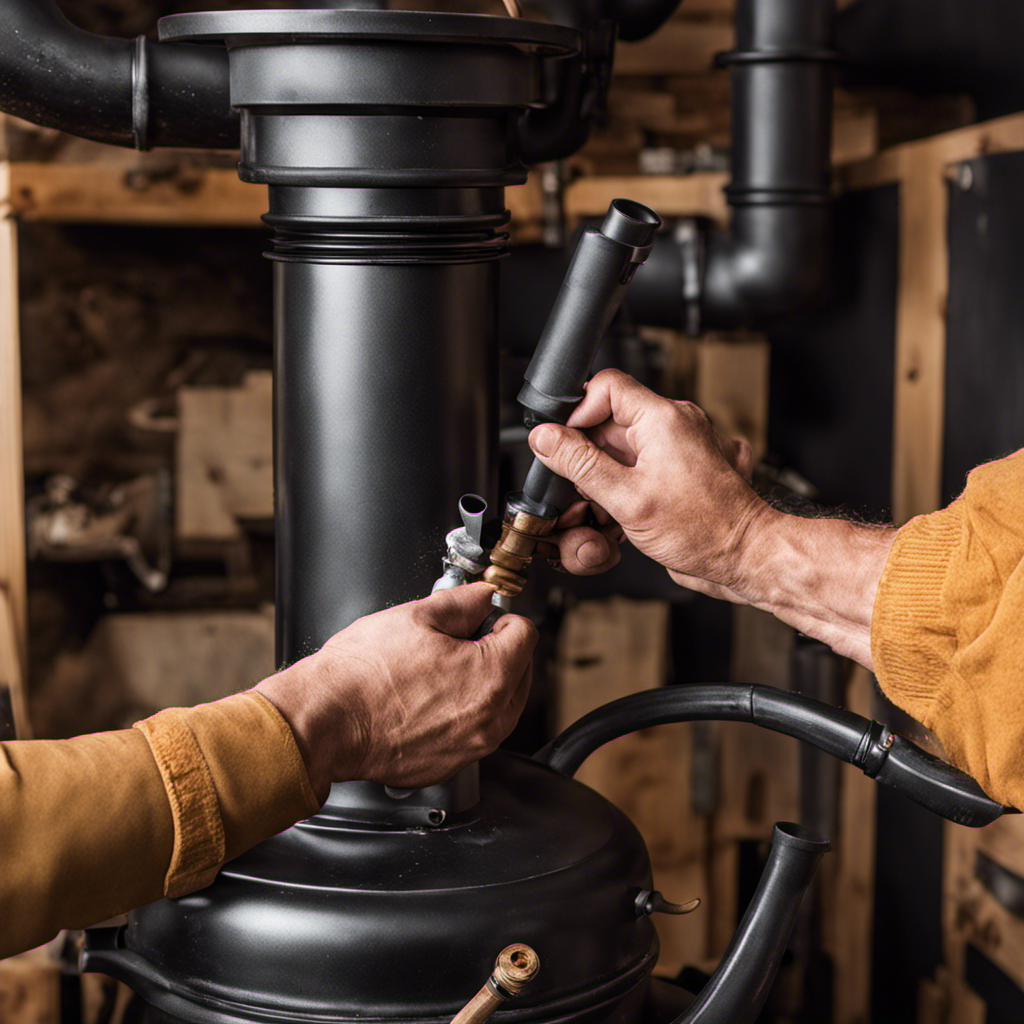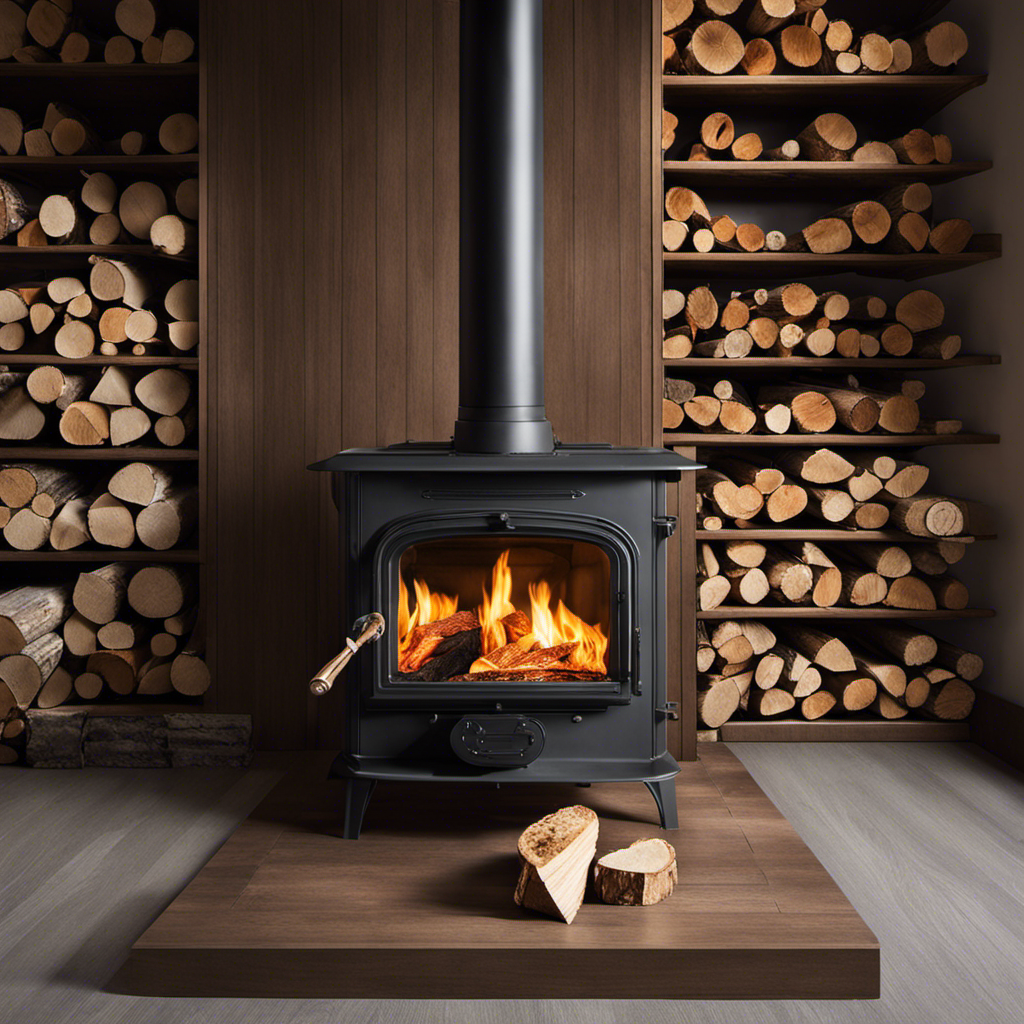Were you aware that allowing your wood stove to remain dirty could decrease its effectiveness by as much as 30 percent?
As someone who has spent years maintaining and cleaning wood stoves, I can assure you that regular cleaning is essential for optimal performance.
In this article, I will guide you through the step-by-step process of cleaning your wood stove, from assessing its condition to maintaining it for future use.
Get ready to enjoy a well-functioning and cozy wood stove all winter long!
Key Takeaways
- Regularly assess the condition of your wood stove, checking for wear and tear, door gasket tightness, firebrick or refractory panel damage, and chimney and flue blockages.
- Gather the necessary cleaning supplies, including a bucket, gloves, stiff brush, vacuum cleaner, non-abrasive wood stove cleaners, and glass cleaner safe for high-temperature surfaces.
- Remove ash and debris from the stove using a small shovel, metal ash bucket, and vacuum cleaner with brush attachment, disposing of ash in a designated outdoor area away from flammable materials.
- Clean the glass door and surrounding areas by wiping with a damp cloth, using glass cleaner for tougher stains, gently scrubbing, and wiping away excess moisture or residue with a dry microfiber cloth.
Assessing the Condition of Your Wood Stove
I’m checking the overall condition of my wood stove before starting the cleaning process. It’s important to evaluate the maintenance needs and inspect the components to ensure everything is in proper working order. As an experienced wood stove owner, I know that a thorough assessment is crucial for the safety and efficiency of the stove.
First, I carefully examine the exterior of the stove. I check for any signs of wear and tear, such as rust or cracks in the metal. Any damage to the exterior could indicate potential issues with the stove’s performance.
Next, I inspect the door gasket to ensure it creates a tight seal when closed. A secure seal is essential for maintaining proper airflow and preventing smoke leaks.
Moving inside the stove, I inspect the firebricks or refractory panels. These components protect the stove’s interior from the intense heat of the fire. If any bricks or panels are cracked or damaged, I make a note to replace them as part of the maintenance process.
Lastly, I assess the chimney and flue. I check for any blockages or creosote buildup, which can be a fire hazard. If necessary, I schedule a professional chimney sweep to clean and inspect the chimney thoroughly.
Gathering the Necessary Cleaning Supplies
To get started, I’ll need a bucket, gloves, a stiff brush, and a vacuum cleaner. These are the essential tools I use when cleaning my wood stove.
Before I begin, I always make sure to gather all the necessary cleaning supplies and organize them in a convenient location. This helps me stay focused and efficient throughout the cleaning process.
When it comes to choosing the right cleaning products, I prefer to use non-abrasive cleaners specifically designed for wood stoves. These cleaners are gentle enough not to damage the delicate surfaces of the stove, yet effective in removing soot, grime, and creosote buildup. I also make sure to have a glass cleaner handy for cleaning the glass door of the stove. It’s important to choose a glass cleaner that’s safe for use on high-temperature surfaces.
In addition to the cleaning products, I always keep a bucket filled with warm water and mild dish soap. This acts as my primary cleaning solution for wiping down the stove and removing any residues. The warm water helps to loosen stubborn dirt, while the mild dish soap helps to break down grease and soot.
With my cleaning tools and supplies organized and ready, I’m now prepared to tackle the task of removing ash and debris from the stove.
Removing Ash and Debris From the Stove
Ash and debris can be safely removed from the stove by using a small shovel and a metal ash bucket. As someone who’s been cleaning wood stoves for many years, I’ve learned the best techniques for effectively and safely removing the ash and debris.
Once the stove has cooled down, I start by carefully opening the stove door and using the small shovel to scoop up the ash and debris. It’s important to be gentle and avoid stirring up too much dust. I then transfer the ash into a metal ash bucket, being cautious not to spill any on the floor or surrounding area.
To ensure a thorough clean, I also use a vacuuming technique. I attach a brush attachment to my vacuum cleaner and carefully vacuum the inside of the stove. This helps to remove any remaining ash or debris that may have been missed with the shovel. It’s crucial to use a vacuum cleaner specifically designed for removing ash, as regular household vacuums can become damaged by the fine particles.
Proper disposal of the ash and debris is essential. I always make sure to empty the ash bucket into a designated outdoor area away from any flammable materials. This prevents any potential fire hazards. Additionally, I never dispose of the ash in plastic bags or containers, as the residual heat can cause them to melt or catch fire.
Cleaning the Glass Door and Surrounding Areas
As an experienced cleaner, I’ve found that wiping the glass door and surrounding areas with a damp cloth is the most effective way to remove any dirt or smudges. Cleaning the glass door is an essential part of maintaining a wood stove, as it not only improves the aesthetic appeal but also allows you to enjoy the cozy ambiance of the fire.
To ensure a thorough clean, I recommend following these steps:
-
Prepare your materials: Gather a damp cloth, glass cleaner, and a dry microfiber cloth.
-
Begin by wiping the glass door with the damp cloth to remove any loose debris or soot residue.
-
For tougher stains, apply a small amount of glass cleaner to the cloth and gently scrub the affected areas.
-
Once the door is clean, use a dry microfiber cloth to wipe away any excess moisture or residue.
By regularly cleaning the glass door, you can prevent the build-up of soot and ensure a clear view of the fire.
Additionally, it’s important to mention that cleaning the chimney is another crucial aspect of maintaining a wood stove. In the next section, I’ll provide detailed instructions on how to effectively clean the chimney and remove any soot residue.
Maintaining and Preventing Future Build-Up
Regular maintenance is key to preventing future build-up and ensuring the longevity of the glass door and chimney. As someone who’s years of experience in maintaining wood stoves, I can confidently say that taking the necessary steps to prevent rust and remove stubborn stains is crucial.
One effective way to prevent rust is by regularly inspecting the glass door for any signs of moisture or condensation. If you notice any, make sure to address the issue immediately to avoid rust formation.
Additionally, it’s important to keep the glass door clean and free from any debris or residue. This can be done by using a non-abrasive glass cleaner and a soft cloth.
When it comes to removing stubborn stains on the glass door, I recommend using a mixture of vinegar and water. Simply spray the solution onto the stained area, let it sit for a few minutes, and then wipe it clean with a cloth.
Frequently Asked Questions
Can I Use Regular Household Cleaners to Clean the Glass Door of My Wood Stove?
Regular household cleaners can be effective for cleaning the glass door of a wood stove. However, it’s important to choose a cleaner that’s safe for use on glass surfaces. Some household cleaners may contain harsh chemicals that can damage the glass or leave streaks.
Alternatively, there are specific glass cleaning methods that can be used, such as using a mixture of vinegar and water or a specialized glass cleaner designed for wood stoves. These methods can provide effective cleaning without the risk of damaging the glass.
How Often Should I Clean the Chimney of My Wood Stove?
Cleaning the chimney of a wood stove is a crucial task for maintaining its efficiency and safety. Regular chimney cleaning is essential to remove creosote buildup, which can cause chimney fires. To clean a chimney effectively, it’s important to use the right tools and techniques.
A professional chimney sweep can ensure a thorough cleaning, removing any debris or blockages. Regular chimney cleaning not only improves the stove’s performance but also reduces the risk of fire hazards.
Is It Necessary to Wear Protective Gear When Cleaning a Wood Stove?
When cleaning a wood stove, it’s absolutely necessary to wear protective gear. Safety precautions should always be a top priority in this task.
Wearing gloves, goggles, and a mask will protect you from the dirt, soot, and debris that can be harmful to your health.
Additionally, having a fire extinguisher nearby is essential in case of any unexpected accidents.
Can I Use a Vacuum Cleaner to Remove Ash and Debris From the Stove?
I’ve found that using a vacuum cleaner to remove ash and debris from a wood stove can be a convenient and efficient method.
However, it’s important to prioritize vacuum cleaner safety. Make sure to use a vacuum specifically designed for this purpose, as regular household vacuums may not be able to handle the heat and fine particles.
Additionally, consider alternative cleaning methods, such as using a brush and dustpan, to ensure a thorough and safe cleaning process.
What Should I Do if My Wood Stove Emits a Strong Odor During Use?
When my wood stove emits a strong odor during use, I take immediate action to eliminate it.
First, I check for any visible signs of buildup or debris inside the stove and clean it thoroughly.
I also make sure to burn only dry and seasoned wood, as wet or unseasoned wood can contribute to odors.
Additionally, I ensure proper ventilation by opening a window or door to allow fresh air in.
Following these tips helps prevent strong odors in my wood stove.
Conclusion
In conclusion, maintaining a clean wood stove is essential for its optimal performance and longevity. Did you know that a well-maintained wood stove can reduce heating costs by up to 30%?
By regularly removing ash, debris, and cleaning the glass door, you can ensure efficient heat output and prevent any potential fire hazards. Remember to always follow the manufacturer’s instructions and consult with a professional if needed.
Happy cleaning!
Growing up surrounded by the vast beauty of nature, Sierra was always drawn to the call of the wild. While others sought the comfort of the familiar, she ventured out, embracing the unpredictable and finding stories in the heartbeat of nature.
At the epicenter of every remarkable venture lies a dynamic team—a fusion of diverse talents, visions, and passions. The essence of Best Small Wood Stoves is crafted and refined by such a trio: Sierra, Logan, and Terra. Their collective expertise has transformed the platform into a leading authority on small wood stoves, radiating warmth and knowledge in equal measure.











